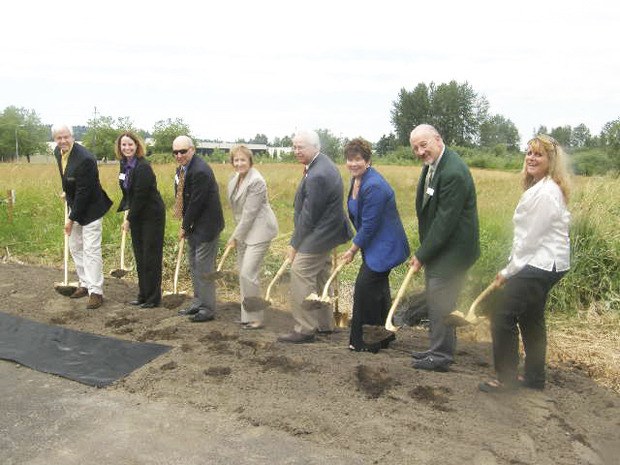Most people in Auburn probably don’t even know the short strip of road behind AMPAC Packaging and Mohawk Northern Plastics exists at all.
But soon that unconnected section, accessible now only through the company’s parking lot, and only during business hours, will make up a key part of the long awaited tie-in of A Street Northwest to B Street Northwest.
When the contractor, Miles Resources, finishes the $9.7 million A-B connector job next summer, a person starting from the Auburn Transit Station will be able to zip all the way north to South 277th Street on a single street. And vice versa.
Dignitaries, including State Sens. Pam Roach and Mark Hargrove, members of the Auburn City Council and the Auburn business community, gathered Monday on what Mayor Pete Lewis called Auburn’s former “road to nowhere” to break ground.
“It will connect a major north-south corridor in our city,” Lewis said. “It will give us another major freight corridor in our city, connecting 3rd Street on the south with 277th Street on the north. It also gives our truck traffic the ability to connect up with 15th Street and State Route 167.”
Along the route, that driver will negotiate a new three- and four-lane road, with sidewalks between 3rd Street Northwest, immediately west of the Auburn Post Office, and 14th Street Northwest.
The project has been in the works for more than 20 years. The late Congresswoman Jennifer Dunn helped with the early funding process, which began in 2005 and ended in 2009.
AMPAC Packaging and Mohawk Northern Plastics built its piece decades ago in anticipation of the connector and in partnership with the City, knowing that the City could use it to seek out funding on a state and federal level.
“It’s progress,” said Bill Gates, former owner of Mohawk Northern Plastics and today one of the owners of its property.
The federal government contributed $6.5 million to the $9.7 million project. In-kind developer contributions total $1.3 million, including the street section. MultiCare, which owns property just south of 14th Street and is reported to be studying development options, has made an in-kind contribution of $400,000.
The A-B Street corridor connector is a byproduct of the Burlington Northern Santa Fe Railroad’s 1994 Stampede Pass Rail Impact Study and one of four projects in Auburn designed to lighten the impact of the rail line’s opening on Auburn traffic. The other three were the 3rd Street grade and 277th grade separation projects and the M Street grade separation. The Stampede Pass line is a secondary BNSF line that starts in downtown Auburn and climbs over the Cascade Mountains.
“You’ve got extremely slow trains using that line,” Ingrid Gaub, assistant city engineer told the Reporter recently. “The BNSF in 1993 reopened the line with the intention of eventually improving the tunnel over the mountains so it can take double-stacked trains through. When they do that, we will see more use of the line. When we did an analysis of all the at-grade crossings and of all the slow moving trains making the turn and getting onto the pass line, we ended up with about eight minutes of blockage through the downtown.
“The A-B connector provides a parallel corridor to the BNSF mainline railroad on the east side, so you can connect from the downtown all the way to 15th Street Northwest, and from there all the way up to 277th,” Gaub said. “That means you can connect from the 3rd Street grade separation to the grade separation at 15th Northwest to the grade separation at 277th and never have to stop for trains. Right now, B Street ends at 14th Street near Taco Time, and to get into the downtown, you have to cut over and get onto A Street or 15th or onto Auburn Way.”
Work should begin work on July 25. Puget Sound Energy is already on site relocating the power lines.
The project includes the completion of approximately 22 acres of wetland mitigation in the City’s Auburn Environmental Park area.
“It isn’t just Auburn’s project, it’s a project for the region and is connected to our future at least through 2040 and beyond,” said Deputy Mayor Sue Singer.
A City of Auburn white paper on the project lists a number of benefits, including the following:
• The 3.5-mile corridor accounts for 70 percent of the city’s projected job growth and supports the growth of more than 5,000 projected new jobs, for a total of 10,000 projected and existing jobs. It supports the development of more than 200 vacant and underdeveloped parcels along the corridor and in the downtown core.
• It increases access to South King County’s only Level 3 trauma center, the Auburn Regional Medical Center. The nearest Level 2 trauma centers are each 10 miles away, one north on SR 167, the other south on SR 512.
• It links the Auburn Transit Station to major retailers, employers and entertainment facilities.
• It provides a parallel route to Auburn Way and SR 167 that will reduce traffic congestion.



